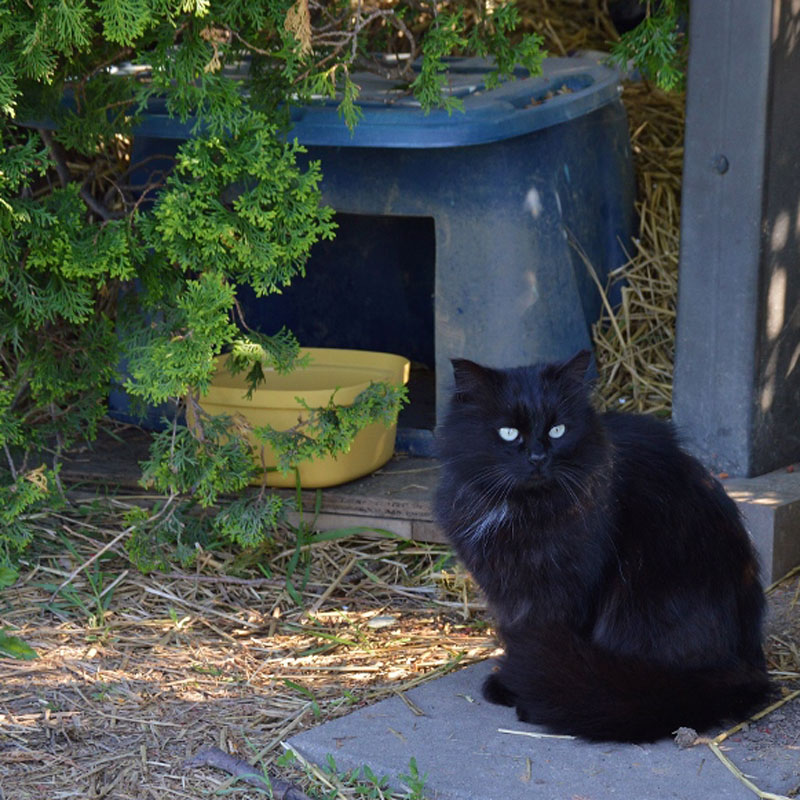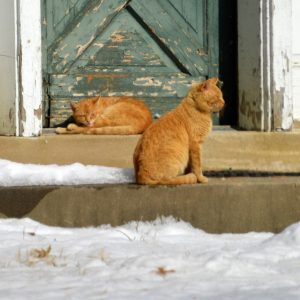
Interview! Anne Lindsay, Founder & President, Massachusetts Animal Coalition (MAC) – Part I
September 22, 2018
Interview! Anne Lindsay, Founder & President, Massachusetts Animal Coalition (MAC) – Part II
September 29, 2018
 With fall just about upon us, it’s time to start thinking about winterizing and cleaning out your feeding stations and feral cat housing. I can’t tell you how many times our committee members have run around in late October/early November trying to get our shelters and feeding stations ready for the winter. It’s better to prepare early so that you don’t get caught with un-winterized shelters and a sudden cold streak, snowfall or one of those nasty, cold fall rains on the way. Even if you live in an area of the country where the weather doesn’t get cold, it is still a good idea to do a deep clean-out of your feeding stations and shelters at least twice a year.
With fall just about upon us, it’s time to start thinking about winterizing and cleaning out your feeding stations and feral cat housing. I can’t tell you how many times our committee members have run around in late October/early November trying to get our shelters and feeding stations ready for the winter. It’s better to prepare early so that you don’t get caught with un-winterized shelters and a sudden cold streak, snowfall or one of those nasty, cold fall rains on the way. Even if you live in an area of the country where the weather doesn’t get cold, it is still a good idea to do a deep clean-out of your feeding stations and shelters at least twice a year.
- In an ideal world, you should have elevated feeding stations so that you don’t attract skunks, raccoons etc. Here is a link to a cool design that we used for many years in Newburyport and surrounding areas: rikkisrefuge.org. There are a lot of great designs out there (as a quick Google search will prove), so you should have no trouble finding something that works for you, your site and your budget. Ideally, you should have 1 feeding station and 1 shelter per 4-6 cats. It is best to have the feeding area and the shelter at least 50 feet away from each other. Cats don’t want to sleep near their food source, as the food can attract potential predators or rival animals.
- In order to clean out a feeding station or shelter properly, you will need work gloves, trash bags, a rake and broom, a sturdy dustpan, straw*, a spray bottle with water, cloths, and duct tape (you never know when you might need it!). (*Make sure to get STRAW, not hay — hay is food; straw is bedding. Straw is hollow and will maintain its ability to insulate even when wet. Hay just gets…wet!)
- Cleaning out your feeders/shelters is a great activity to do in late September/early October on a nice weekend. I would recruit friends to help if you can. Many hands make light work — plus, some of the wet straw left over from last year can be heavy. October 16 is National Feral Cat Day (sponsored by Alley Cat Allies). Wouldn’t it be great to devote this day (or a weekend day close to it) to helping get all of the shelters and feeding stations in your community ready for winter?
- At each station, you will pull out the old straw from the shelters and sweep the feeding areas clean with your dustpan and broom. Repair anything that needs fixing. Do your best to clean the inside of the shelters, but don’t use any cleaners with a strong odor like bleach, or heavily perfumed products, etc. The cats might not like the smell, so a light cleaning with a spray bottle of water is a better idea. Once everything is clean and as dry as possible, re-stock the shelters with fresh, dry straw. Then sweep or rake the area clean, and put last year’s straw into trash bags for easy transport (hopefully to a compost pile!). Please consider going one step farther and cleaning up any trash in the area. Even if the trash isn’t yours, the neighbors in the area will appreciate the extra effort, and good relations with the neighbors are so important in practicing TNR!
- Throughout the year, after a storm or heavy rain, it is wise to check the straw in your shelters to make sure it is dry. You can help increase the chances that it will be by placing your shelters and feeding stations carefully. Face them away from the prevailing winds in your area so that the cold air, rain and snow don’t blow in. In the winter, you can use microwavable heating discs (Google “Snuggle Safe” discs for an example) in the feeding stations to help keep food thawed, or in shelters for extra warmth. You can also use disposable hand warmers for this purpose. They can be used under water bowls to help keep the water from freezing right away. If you have other ideas on keeping water from freezing during cold temperatures, please let us know! Note that NO cloth (not even cozy fleece blankets!) should be put in shelters. It will get wet, and then it will freeze, essentially turning into a big cloth ice pack, which isn’t so helpful when we’re trying to keep the cats warm, not cold!
- If you use heavy bowls that stay at the location, replace with new or freshly cleaned bowls. Note that heavy plastic or stainless steel will work best for water in freezing temperatures.
- Finally, if you depend on caretakers nearby to do regular feedings, the fall is a good time to check in with them, provide them with new supplies, and ask about the general health of the colony and whether there are any newcomers. Also make sure that feeders have a contact number to call if something should happen to a cat over the winter or if someone new is abandoned. Depending on where you live, you also might want to make sure you have a back-up plan for days when the weather is really bad — and a plan for shoveling out shelters and feeding stations after a big storm!
- With several feeding stations, this fall clean-out process can take a while, but it is well worth it to know that the cats will have clean, comfy, toasty quarters for the upcoming winter!
If you need some inspiration on the best ways to shelter your colonies from the upcoming winter, here’s a link to some great ideas for feral cat shelters, from super-basic to deluxe: worldsbestcatlitter.com/clearing-the-air/2016/02/10-awesome-winter-shelters-for-feral-cats/. A quick search on Google will turn up even more ideas for shelters and for feeding stations. I even found a link to buy a feeding station on Etsy!
Happy cleaning, and be sure to reach out and let us know how you shelter and feed your community cats!




